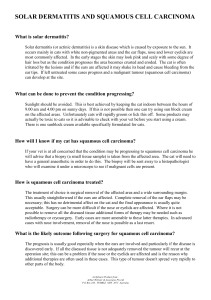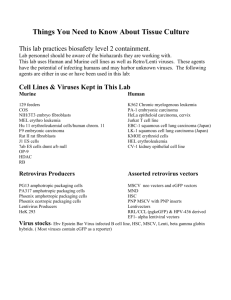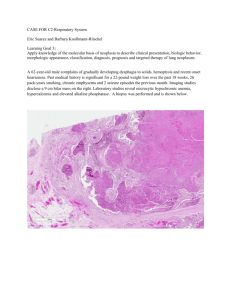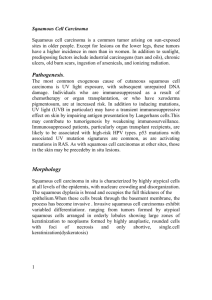Diagnostically Challenging Cases in Gynecologic Pathology
advertisement
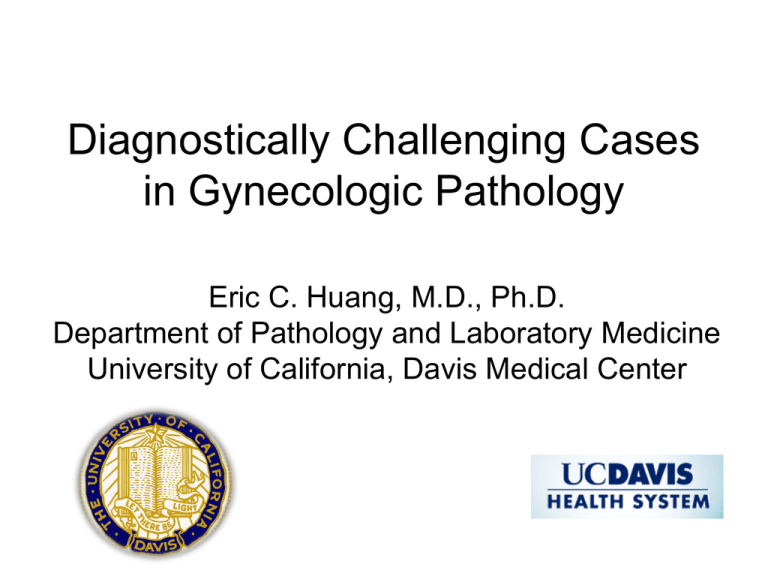
Diagnostically Challenging Cases in Gynecologic Pathology Eric C. Huang, M.D., Ph.D. Department of Pathology and Laboratory Medicine University of California, Davis Medical Center Case 1 Presentation • 38 y/o G3P1021 Caucasian who presented for 1 month postpartum visit. She was noted to have a 5 cm cervical fibroid during delivery • Cervical exam: large 3x3 cm fibroid prolapsing through the cervix • Intraoperative excision was performed and sent to pathology Differential Diagnosis • Squamous cell carcinoma Squamous Cell Carcinoma • An invasive epithelial tumor composed of squamous cells of varying degrees of differentiation • HPV is present in virtually all cases • Currently 25% of stage IB tumors occur in women <40 years and 5% in women ≤ 30 years • Decline by ~75% in the last 50 years in the US due to cervical screening programs Differential Diagnosis • Squamous cell carcinoma • Clear cell carcinoma Clear Cell Carcinoma • An adenocarcinoma composed predominantly of clear or hobnail cells whose architectural patterns are solid, tubulocystic and/or papillary • Comprising ~4% of all cervical ACAs • Associated with in utero diethylstilbestrol exposure (mean age = 19) • Sporatic CCC (mean age = 47) Differential Diagnosis • Squamous cell carcinoma • Clear cell carcinoma • Lymphoepithelioma-like carcinoma Lymphoepithelioma-Like Carcinoma • A distinct subset of squamous cell carcinoma • Rare tumor and represents <1% of all primary cervical neoplasms • EBV is found is ~75% of cases • ~20% are associated with HPV 16 and 18 Glassy Cell Carcinoma • A distinctive type of large cell carcinoma that may be pure or admixed with an otherwise typical endocervical adenocarcinoma or adenosquamous carcinoma • 83% of patients were <35 y/o • HPV18 has been identified in some tumors Microscopic Features • Nests of large cells with – Abundant eosinophilic or amphophilic groundglass cytoplasm – Distinct cell borders – Large nuclei – Macronucleoli – High mitotic rate • Dense stromal inflammatory infiltrate composed predominantly of eosinophils and plasma cells Case 2 Presentation • 30 y/o G0P0 morbidly obese Caucasian female with no significant PMH presented with recurrent vaginal bleeding and foul smelling discharge • Cervical exam: necrotic mass protruding through the dilated cervical os • Multiple biopsies were performed and sent to pathology Differential Diagnosis • Adenosarcoma Adenosarcoma • A mixed epithelial and mesenchymal tumor, in which the epithelial component is benign or atypical and the stromal component is low-grade malignant • ~8% of all uterine sarcomas • Occurs in all ages (15-90 y/o) with a median of 58 • Presenting with abnormal vaginal bleeding but there may also be discharge or a mass protruding into the vagina Mitoses Differential Diagnosis • Adenosarcoma • Carcinosarcoma Carcinosarcoma • A biphasic tumor composed of high-grade carcinomatous and sarcomatous elements • Most common subtype of mixed müllerian tumors • Usually occur in elderly postmenopausal women (mean age = 65 y/o) • Occasional cases may occur in younger women Differential Diagnosis • Adenosarcoma • Carcinosarcoma • Mesonephric carcinoma Mesonephric Carcinoma • An adenocarcinoma arising from mesonephric remnants • Most often located in the lateral to posterior wall of the cervix • Range in age from 33-74 years (mean=52 years) • Vast majority arise in a background of mesonephric remnant hyperplasia Mesonephric Hyperplasia Mesonephric Hyperplasia • Lack of irregular, disorderly invasion • Lack of back-to-back glandular crowding • Lack of mitotic activity • Lack of nuclear atypia • Lack of lymphatic/ vascular/perineural invasion Mesonephric Carcinoma Ductal Spindle Mesonephric Carcinoma Calretinin CD 10 H&E ER PAX8 PR H&E CD10 WT-1 Calretinin Extra-renal Wilms Tumor • A malignant tumor showing blastema and primitive glomerular and tubular differentiation resembling Wilms tumor of the kidney • Typically presented with abnormal vaginal bleeding and/or a mass • 16 cases reported in the literature (7 adults, 9 children) – Predominantly a disease of childhood Microscopic Features • Epithelial component - small tubules or cysts lined by primitive columnar or cuboidal cells – Fetal-type glomeruloid structures • Mesenchymal component - loose myxoid and fibroblastic spindle cell stroma • Blastemal component - small cells with hyperchromatic, rounded nuclei surrounded by a small amount of basophilic cytoplasm Questions? • eric.huang@ucdmc.ucdavis.edu



